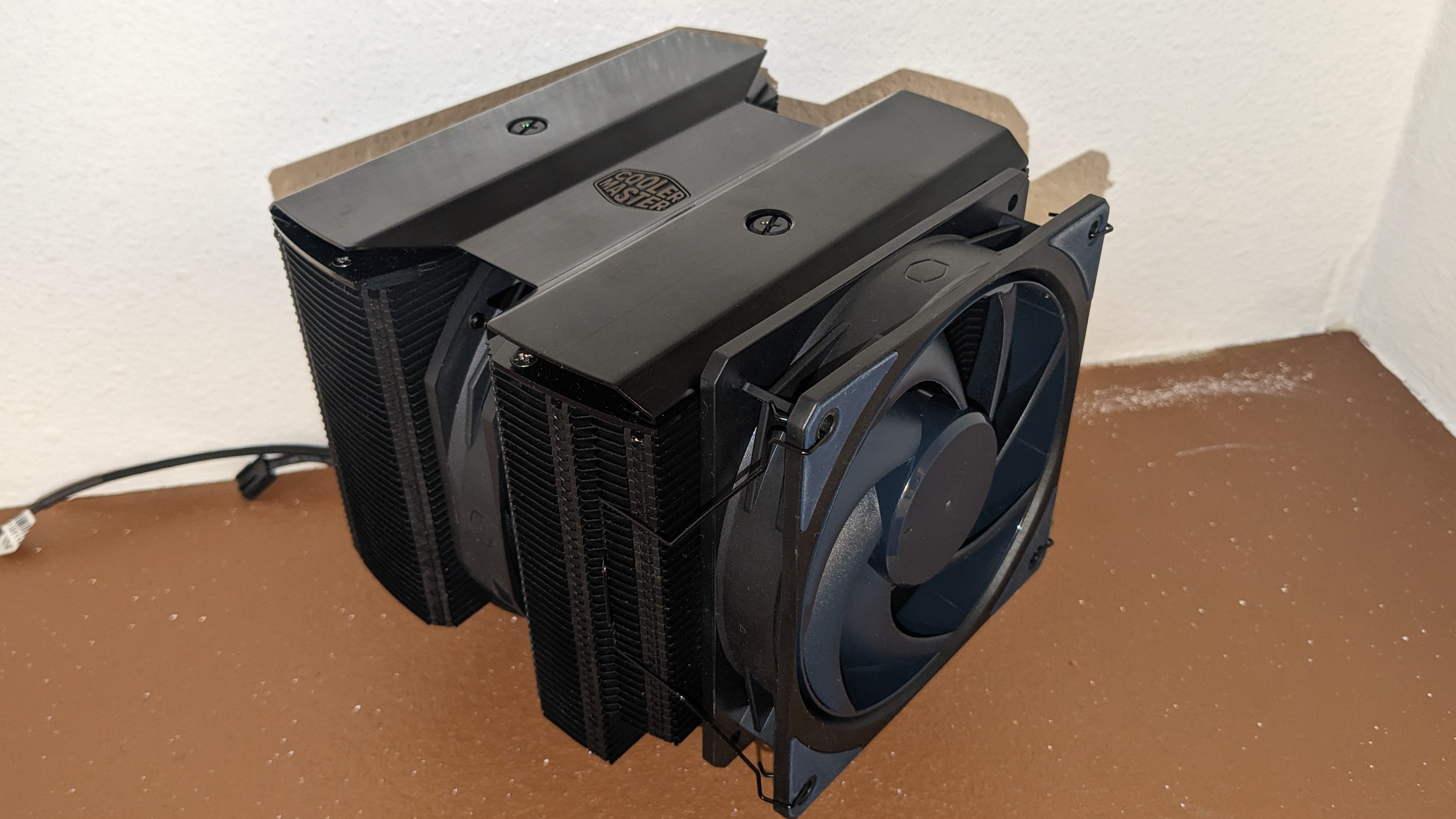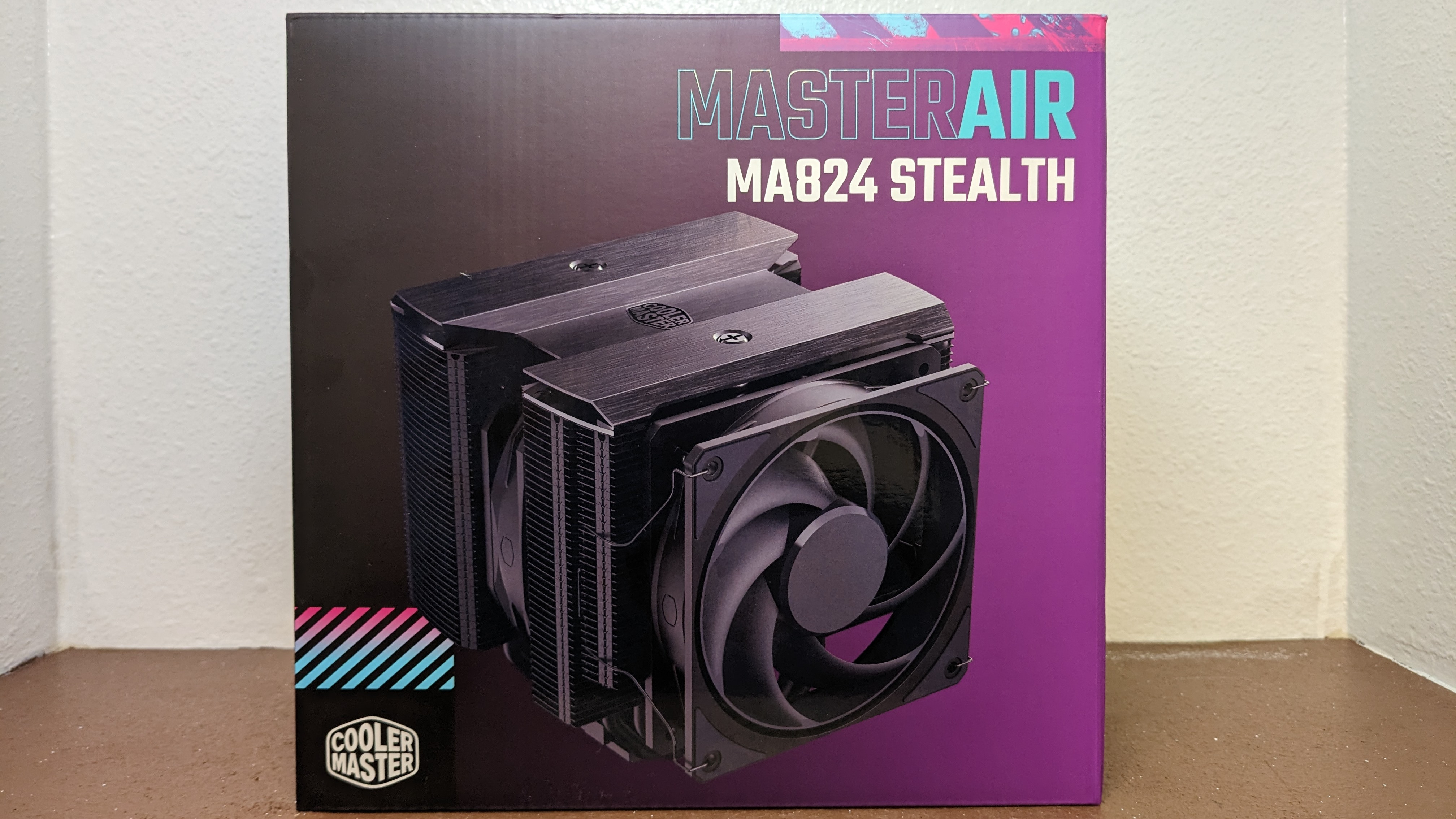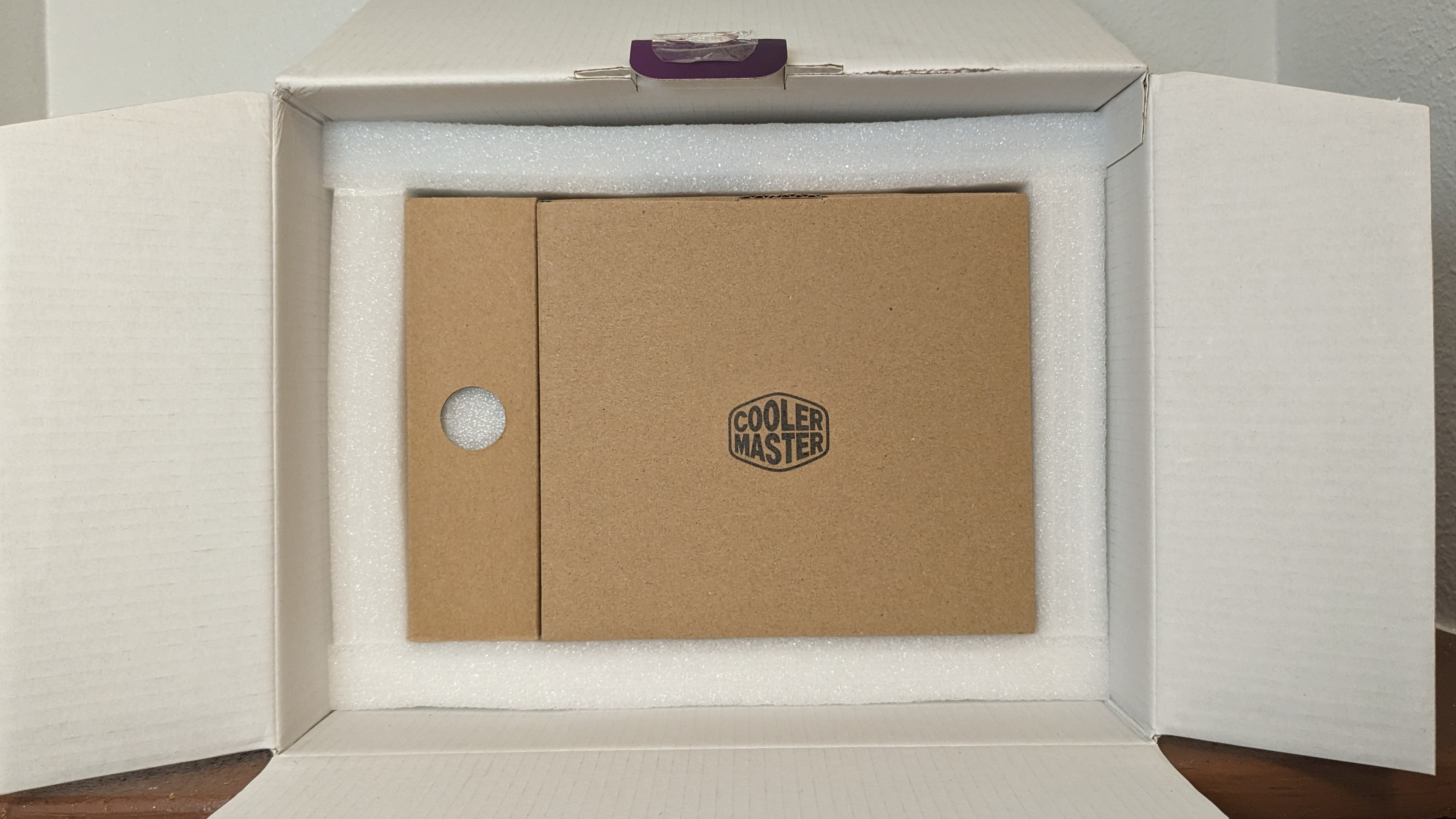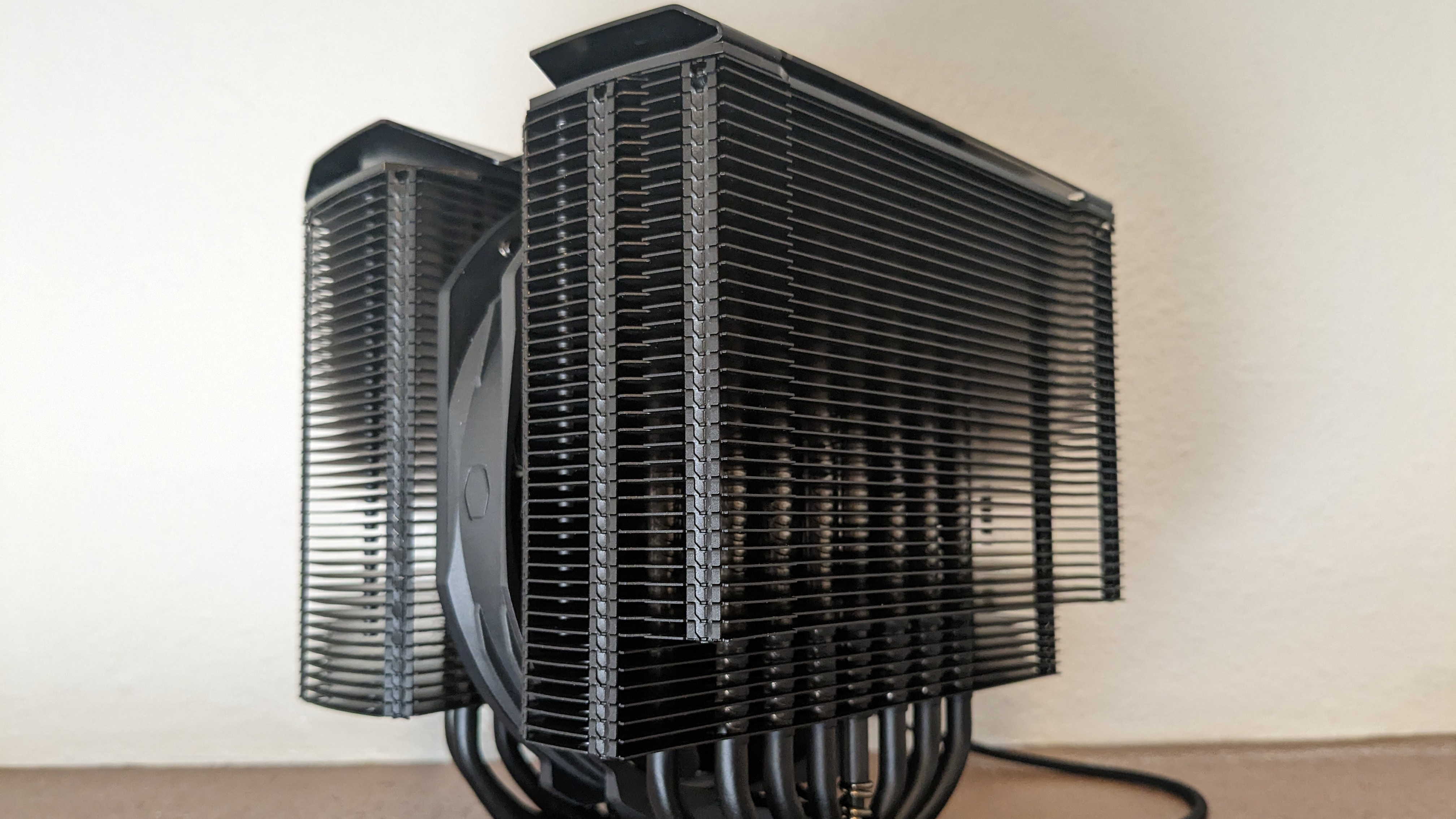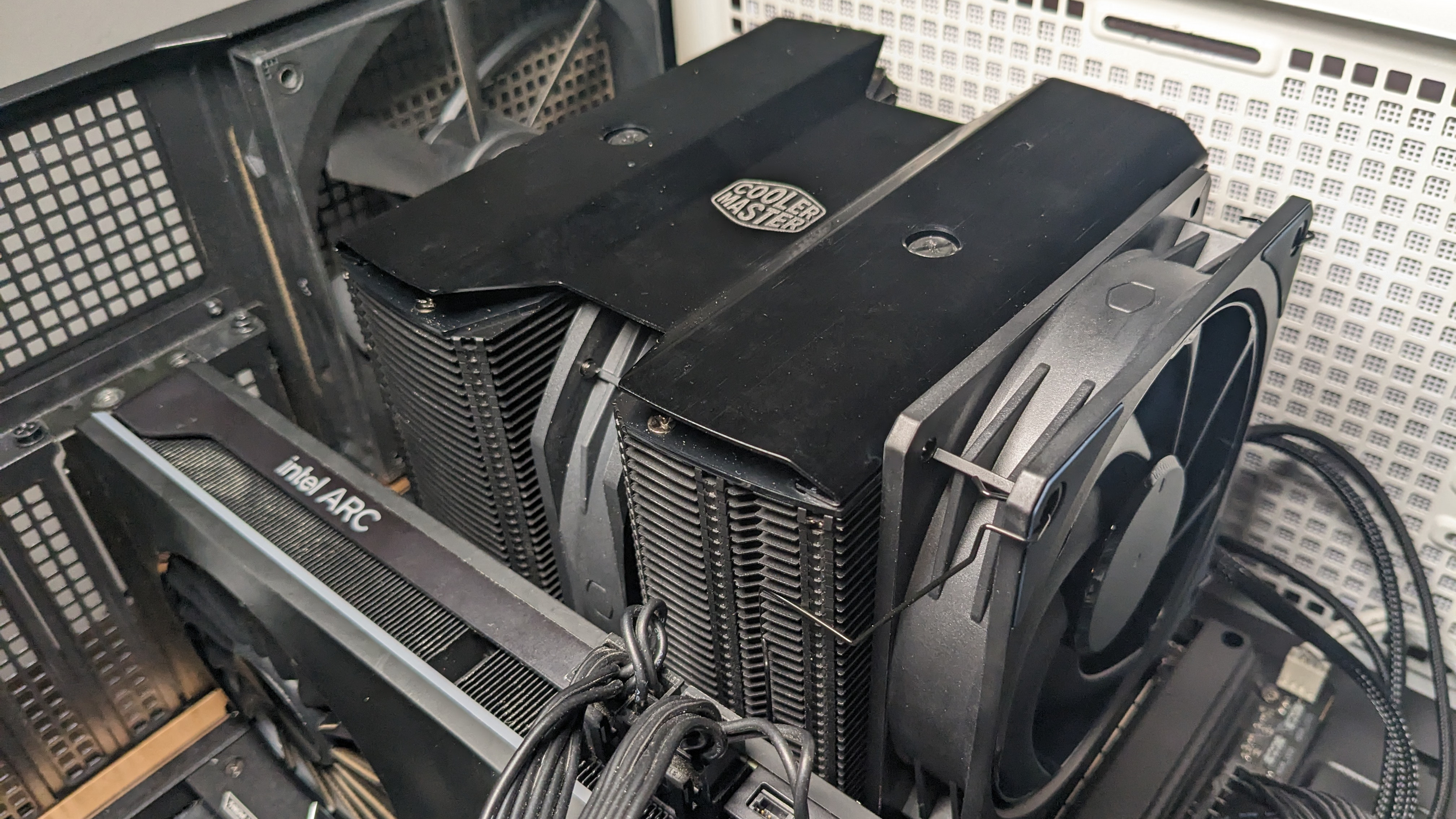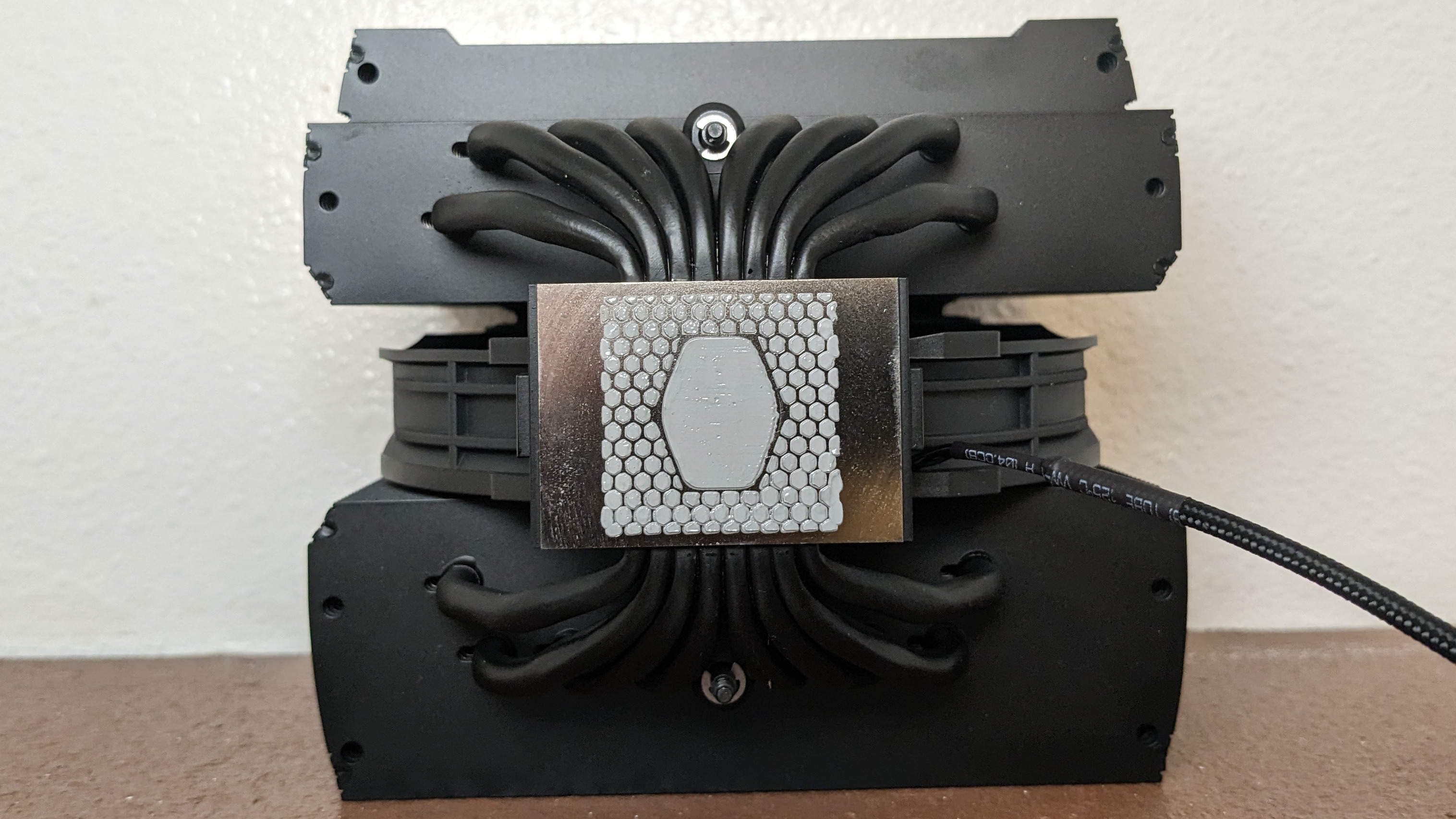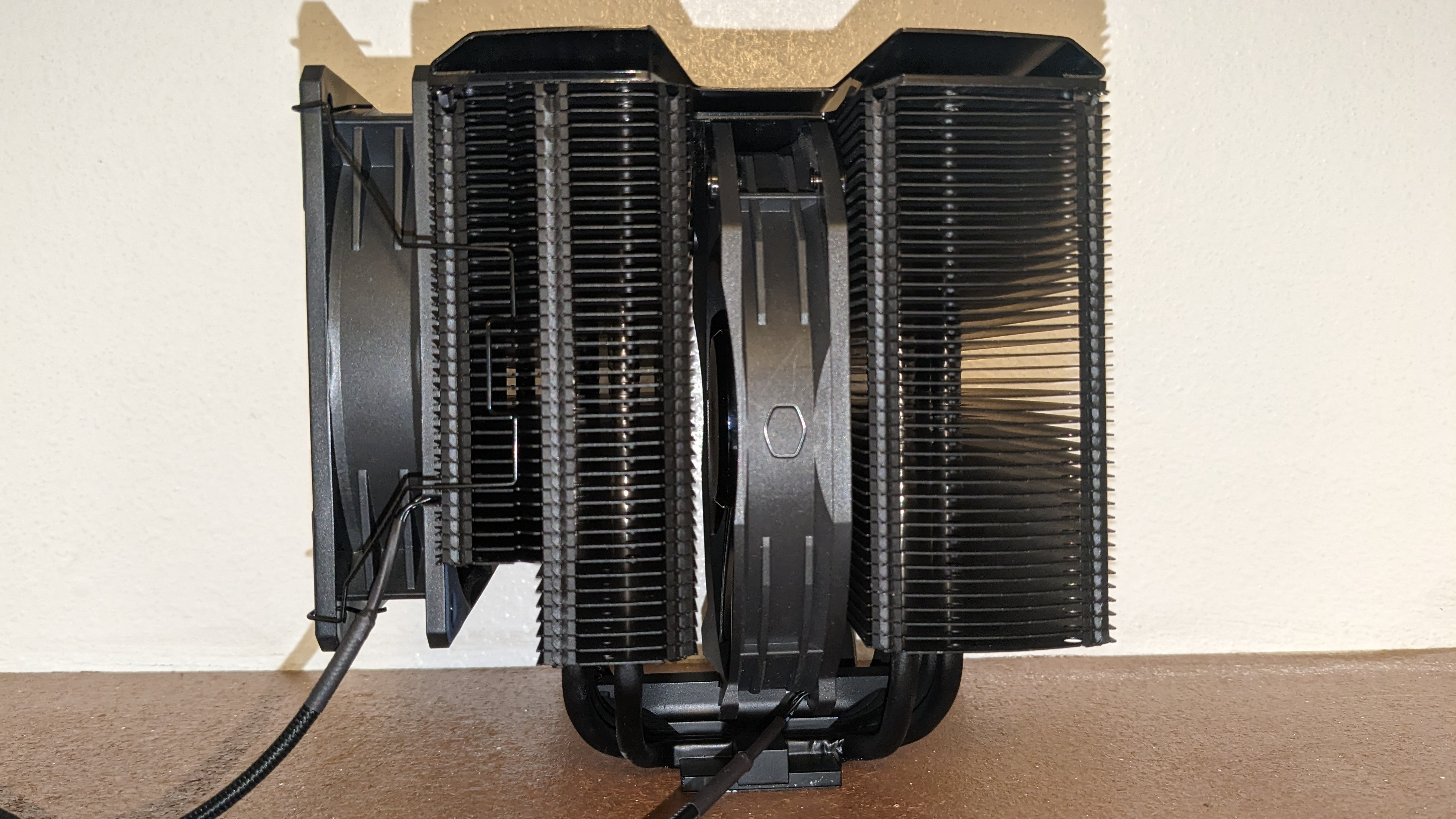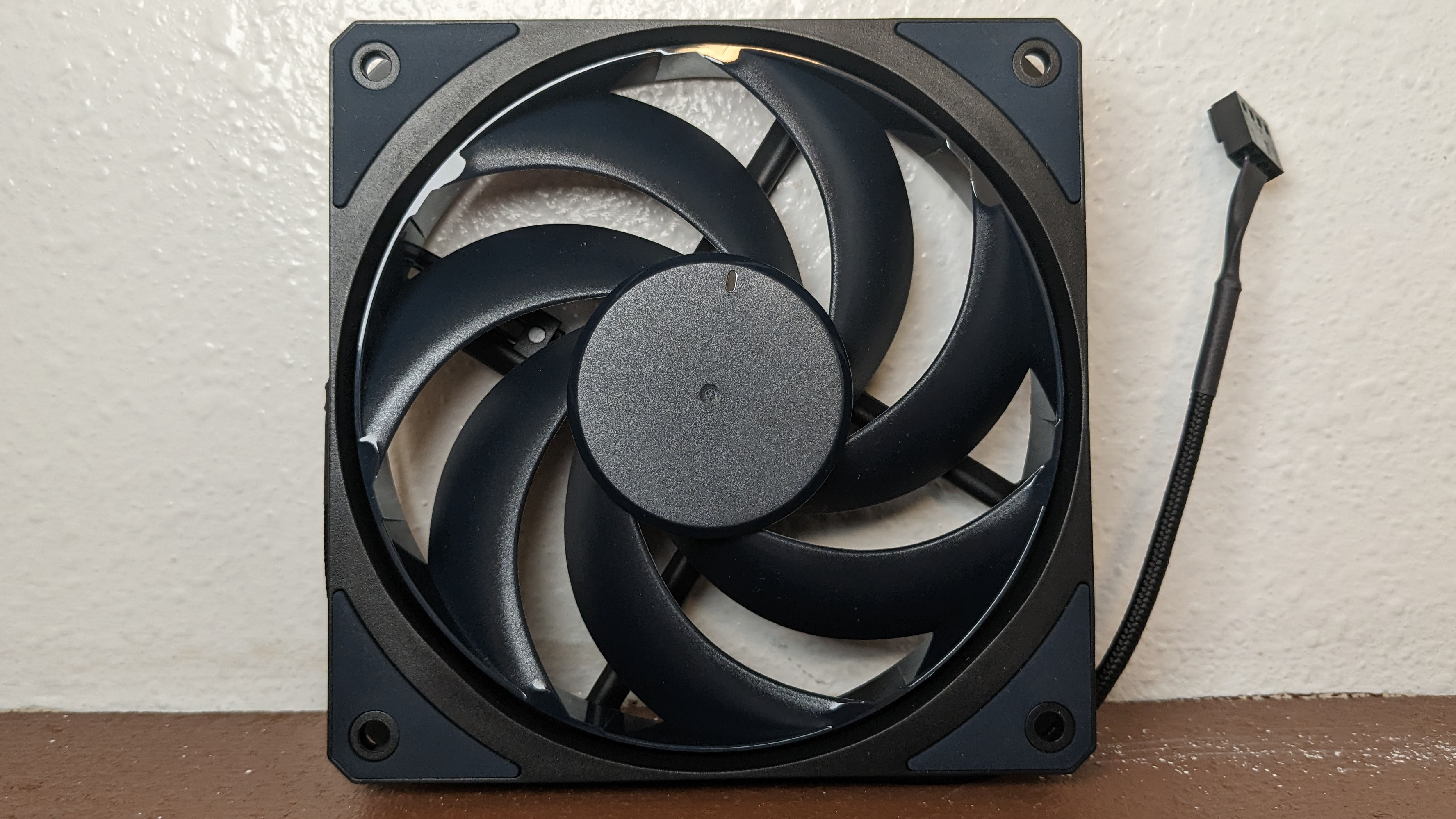Tom's Hardware Verdict
Cooler Master's MA824 Stealth rivals Noctua’s NH-D15S, while running at lower noise levels. That makes it one of the best air coolers on the market.
Pros
- +
Unique design
- +
Top-tier air cooling performance
- +
Quiet Operation
- +
42mm of RAM clearance
Cons
- -
Middle fan is permanently attached
- -
Expensive
Why you can trust Tom's Hardware
Cooler Master’s influence in the realm of PC cooling is undeniable. Well known for products like the classic Hyper 212 Evo air cooler and its giant HAF series of PC cases amongst other offerings, the company has recently been expanding its offerings even further, with its MasterHub modular Stream Deck competitor impressing us at Computex recently.
I was also impressed when I demoed the company’s Cooling X pre-built system at CES, an interesting fanless pre-built computer, that features a 7950X3D and RTX 4080 in a unique liquid loop, which utilizes the computer case to act as a giant heatsink to cool the components effectively without fans.
Next month, Cooler Master will also be launching its new MasterControl software which will offer control of cooling and other hardware via an open API. Today though, we’re looking at Cooler Master’s latest air cooler, the MA824 Stealth. The company is clearly aiming for air cooling supremacy here. The Stealth a formidable challenger that features 8 heatpipes of varying widths, upgraded fans, and a supremely simple installation process. But is that enough to outmatch Noctua’s NH-D15S?
To answer that question, I rested the Noctua’s king of air cooling specifically for this review to find out if the MA824 has what it takes to dethrone Noctua and land a spot in our list of best coolers. But before we look at the benchmarks, let’s look at the features and installation of this cooler.
Cooler Specifications
| Cooler | Cooler Master MasterAir MA824 Stealth |
| MSRP | $99.99 USD |
| Installed Size | 162.2 (L) x 150.6 (W) x 165.6 (H) |
| Radiator Material | Aluminum |
| Heatpipes | 8x Copper Heatpipes of variable thickness |
| Socket Compatibility | Intel: LGA1700, LGA1200, LGA1151, LGA1150, LGA1156, LGA1155 |
| AMD: AM5 & AM4 | |
| Base | Nickel plated Copper |
| Max TDP (Our Testing) | 233W on Intel i7-13700K, 126W on AMD Ryzen 7 7700X |
Packing and Included Contents
Cooler Master’s MA824 MasterAir Stealth arrives in a box that’s pretty large for an air cooler, at 8x10x9.5 inches. But of course, this isn’t a small cooler.
The inner contents are protected with foam, cardboard, and plastic – ensuring the cooler arrives in pristine condition no matter how rough the shipping was.
Included with the package are the following:
- Dual-tower heatsink with pre-installed 140mm fan
- 1x 120mm fan
- Fan Clips
- Mounts for all modern CPU sockets (including AM5 and LGA1700)
- PWM splitter cable
- Thermal paste
- Screwdriver
- Manual & Warranty leaflets
Installation on LGA1700 and AMD AM4 AM5
Cooler Master has clearly prioritized user convenience with the Master Air MA824 Stealth. The installation process has been streamlined to the point that I would consider it one of the easiest coolers to install.
Get Tom's Hardware's best news and in-depth reviews, straight to your inbox.
It’s very simple, whether you’re using an AMD Ryzen- or Intel-based motherboard. Users of any and all experience levels should find no difficulty during installation.
First, if you’re running an AMD Ryzen system, you’ll need to start by removing the default retention bracket. Intel users will need to apply the backplate to the motherboard. Next, for either CPU company, secure the mounting standoffs to the motherboard.


Then, place the mounting bars above the mounting standoffs and secure them with the included thumbscrews.

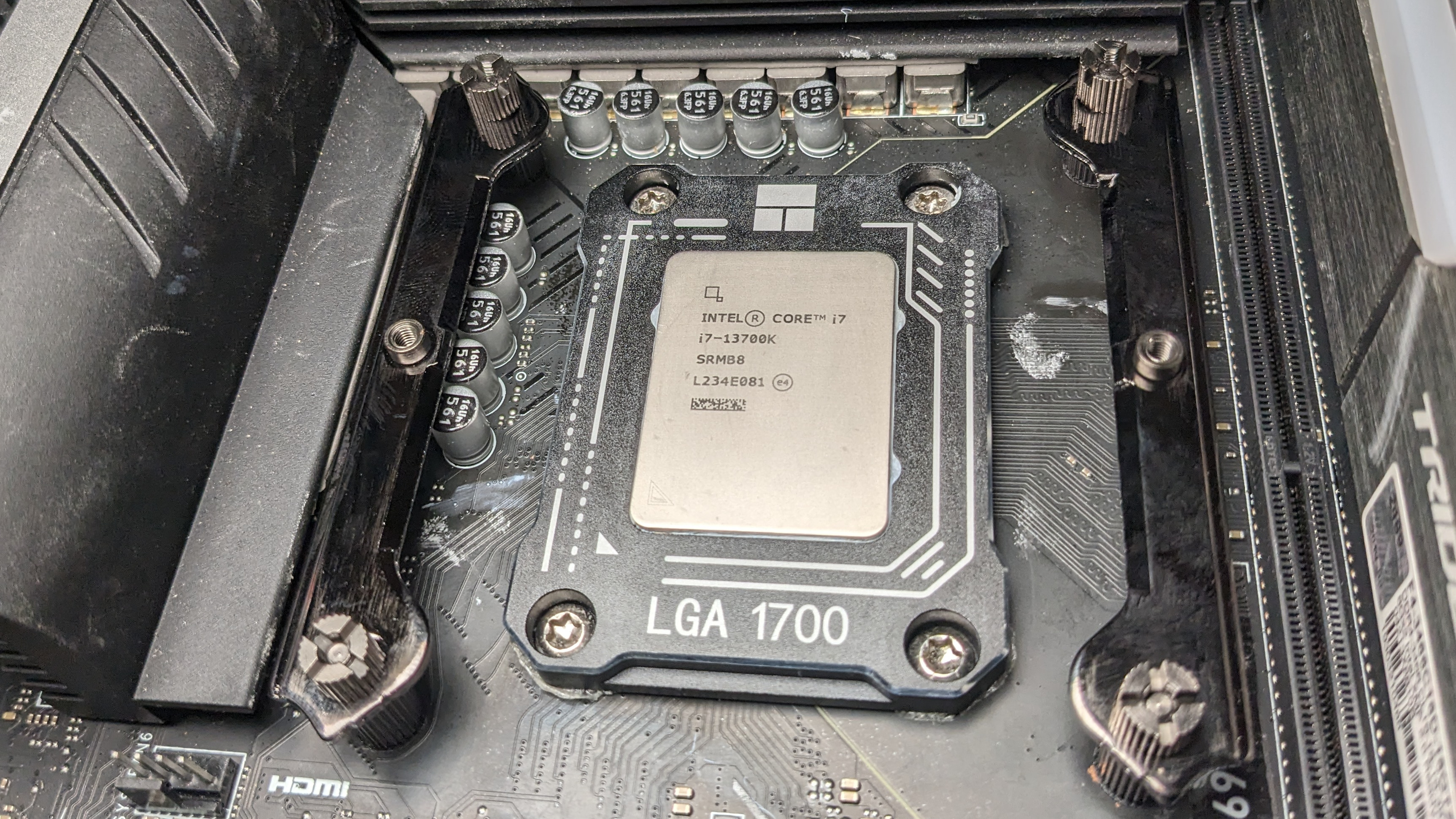
Take the heatsink and press it against the mounting bars, then secure using the screws on top of the cooler.
Lastly, attach the back 120mm Mobius fan using the included clips, and then connect the fans to the motherboard using the included PWM splitter cable.
Features of Cooler Master’s MA824 Stealth
⋇ Eight Heatpipes, Pre-Applied thermal paste
Cooler Master’s MA824 Stealth features eight heatpipes, which is the most we’ve ever seen included on an air cooler. But these heatpipes are a little different than those included with other coolers. Most cooling heatpipes are of uniform thickness, but the thickness of the MA824’s heatpipes varies.
The cooler arrives with Cooler Master’s Cryofuze thermal paste pre-installed on the cooler.
⋇ 42mm RAM Compatibility
The back end of the MA824 is recessed, allowing for 42mm (1.65 inches) of clearance for DDR4 or DDR5 DIMMs.
⋇ Full Mini-ITX compatibility
Some high end air coolers won’t fit properly on a Mini-ITX motherboard - but that’s not a problem with Cooler Master’s MA824 Stealth, it fits motherboards both large and small.
⋇ Solid all black “Stealth” design
The MA824 features a solid, all black, “stealth” design with an aluminum top cover and no aRGB lighting.
⋇ Two Mobius fans, 120mm and 140mm
There’s more to a cooler than just the heatsink or radiator. The bundled fans have a significant impact on cooling and noise levels. The MA824 comes with two fans: one pre-installed 140mm that’s not designed to be removed, and one 120mm fan. Both fans are from Cooler Master’s new Mobius lineup, which deliver strong airflow at low noise levels.
Cooler Master advertises the following features with its Mobius lineup of fans:
- Ring Blade Design (RBD): Interconnecting fan blades designed for a reinforced and rigid structure, eliminating vibration for stable and fluid fan operation.
- Angled inner frame rim with chambered side vents boost airflow draw, maximizing force induced air pressure and diminishing dead air.
- Loop Dynamic Bearing: New bearing design utilizes thick oil coating and lubrication to allow for stable performance.
- Oil Reflow: The oil flows back to the sealed bearing to create constant lubrication against friction and increases the lifespan of the fan.
- Anti-Sway System: a magnetic ring prevents the bearing shaft from tilting, stabilizing the fan to prevent fan blade obstruction under various orientations.
| Model | Mobius |
| Dimensions | 135 x 135 x 26 mm |
| 120 x 120 x 25 mm | |
| Fan Speed | 135mm Fan: 0-1550 RPM ± 15% |
| 120mm Fan: 0-1950 RPM ± 15% | |
| Air Flow | 135mm Fan: 63.6 CFM (Max) |
| 120mm Fan: 63.1 CFM (Max) | |
| Air Pressure | 135mm Fan: 1.92 mmH₂O |
| 120mm Fan: 2.69 mmH₂O | |
| Bearing Type | Loop Dynamic Bearing |
| Lighting | None |
CPUs Used for Testing
Modern CPUs, whether Intel or AMD, are difficult to cool in intensive workloads. In the past reaching 95C+ on a desktop CPU might have been a cause for concern – but with today’s top-end CPUs, this is considered normal operation. Similar behavior has been present in laptops for years due to cooling limitations in tight spaces.
Since last fall, Tom’s Hardware has brought you cooling reviews using one of the most power-hungry desktop CPUs on the market – Intel’s flagship i9-13900K. To give you an idea of what it takes to cool Intel’s behemoth, we’ve tested it with a variety of coolers from basic low-end air coolers like the Amazon Basics CPU cooler to high-end 420mm AIOs such as Corsair’s iCUE H170i Elite.
While it’s nice to see how Intel’s flagship responds to different levels of cooling, those results don’t always correlate with lower-tier CPUs. Today’s review features two CPUs more commonly purchased by end users – AMD’s Ryzen 7 7700X and Intel’s i7-13700K.
LGA1700 Socket Bending
Note that there are many factors other than the CPU cooler that can influence your cooling performance, including the case you use and the fans installed in it. A system's motherboard can also influence this, especially if it suffers from bending, which results in poor cooler contact with the CPU.
To prevent bending from impacting our cooling results, we’ve installed Thermalright’s LGA 1700 contact frame into our testing rig. If your motherboard is affected by bending, your thermal results will be worse than those shown below. Not all motherboards are affected equally by this issue. I tested Raptor Lake CPUs in two motherboards. And while one of them showed significant thermal improvements after installing Thermalright’s LGA1700 contact frame, the other motherboard showed no difference in temperatures whatsoever! Check out our review of the contact frame for more information.
Testing Methodology
All testing is performed at 23 degrees Celsius ambient room temperature. Multiple thermal tests are run on each CPU to test the cooler in a variety of conditions, and acoustic measurements are taken with each result. These tests include:
1. Noise-normalized testing at low noise levels
2. “Out of the box”/Default Configuration Thermal & Acoustics Testing
a.) This means no power limits on Intel’s i7-13700K, and AMD’s default power limits on AMD’s Ryzen 7 7700X.
b.) Because CPUs hit Tjmax in this scenario, the best way to compare cooling strength is by recording the total CPU package power consumption.
3. Thermal & Acoustics testing in Power Limited Scenarios
a.) With Ryzen 7 7700X, I’ve tested with limits of 95W and 75W enforced.
b.) On Intel’s i7-13700K, I’ve tested with limits of 175W and 125W enforced.
The thermal results included are for 10-minute testing runs. To be sure that was sufficiently long to tax the cooler, we tested both Thermalright’s Assassin X 120 R SE and DeepCool’s LT720 with a 30-minute Cinebench test with Intel’s i9-13900K for both 10 minutes and 30 minutes. The results didn’t change much at all with the longer test: The average clock speeds maintained dropped by 29 MHz on DeepCool’s LT720 and 31 MHz on Thermalright’s Assassin X 120 R SE. That’s an incredibly small 0.6% difference in clock speeds maintained, a margin of error difference that tells us that the 10-minute tests are indeed long enough to properly test the coolers.
| CPU | Intel Core i7-13700K |
| Air Coolers Tested | Jiushark JF13K Diamond |
| Thermalright Silver Soul 135 | |
| Thermalright Peerless Assassin | |
| Montech D24 Premium | |
| Noctua NH-D15S | |
| Motherboard | MSI Z690 A Pro DDR4 |
| GPU | Intel ARC A770 LE |
| Case | Be Quiet! Silent Base 802, system fans set to speed 1 setting. |
| Monitor | LG 45GR95QE |
| PSU | Cooler Master XG Plus 850 Platinum PSU |
| CPU | AMD Ryzen 7 7700X |
| Air Coolers Tested | Jiushark JF13K Diamond |
| Thermalright Silver Soul 135 | |
| Thermalright Peerless Assassin | |
| Montech D24 Premium | |
| Noctua NH-D15S | |
| Motherboard | ASRock B650E Taichi |
| GPU | Intel ARC A770 LE |
| Case | DeepCool CK560WH |
| Monitor | LG 45GR95QE |
| PSU | DeepCool PQ1000M |

Albert Thomas is a contributor for Tom’s Hardware, primarily covering CPU cooling reviews.
-
Phaaze88 So this level of performance was already available 8 years ago - about 2.5 years ago, if you wanted the Chromax version.Reply
Ehh. -
deesider Reply
Would be even better if using the Noctua fans...Phaaze88 said:So this level of performance was already available 8 years ago - about 2.5 years ago, if you wanted the Chromax version.
Ehh. -
Phaaze88 Reply
Have doubts, but definitely more expensive...deesider said:Would be even better if using the Noctua fans... -
10tacle I don't like the permanent mount center fan. I'd like to have more control over the fans I can choose down the road. However, for about $30 USD less than what I paid for my NH-D15 (Chromax.BLACK) it's holding its own against it.Reply
Now the interesting thing will be how Noctua's successor to the NH-D15 which is reportedly coming out this fall improves upon the current design and performance. -
Math Geek for the 7700x it is nice to see that for 60% less you can get almost the same performance and just get the peerless assassin :)Reply
no need to spend any more than the $40 for the AMD chip. you only need to spend $100+ if you are running an intel space heater. -
Brian D Smith "Expensive"??? That's a heck of a lot cheaper than your average 'Water Cooler'....and no maintenance.Reply -
YSCCC now the D15S is a single fan version, with the old D15 with dual fan the noise level likely could be lowered by a lot, and for any cooler at this price range I do exect it could be user replacable fans which, when the unfortunate happens, is simply swarpable, and not stuck in the middle hindering airflowReply -
thestryker I'm curious how this and the D15 perform on the 13900K test bench. I have really liked the uncapped wattage tests as they give a great example of cooling capacity (at least on Intel). I'm not sure if the 13700K just doesn't boost as high (or is just a poor bin in this case), but I'd imagine both coolers could handle over 233W.Reply
This isn't the pricing market I'm usually in for air cooling, but that permanent middle fan would certainly rule this one out if I was. -
Albert.Thomas Reply
Well, expensive for an air coolerBrian D Smith said:"Expensive"??? That's a heck of a lot cheaper than your average 'Water Cooler'....and no maintenance. -
Albert.Thomas Replythestryker said:I'm curious how this and the D15 perform on the 13900K test bench. I have really liked the uncapped wattage tests as they give a great example of cooling capacity (at least on Intel).
Thanks!
thestryker said:I'm not sure if the 13700K just doesn't boost as high (or is just a poor bin in this case), but I'd imagine both coolers could handle over 233W.
They would be able to handle more... if paired with a i9-13900K. The i9 can handle more watts both due to better binning, but also because the heat is spread across a larger area because it has 8 more e-cores.
Top end air coolers can handle ~285W on Intel's i9-13900K.

